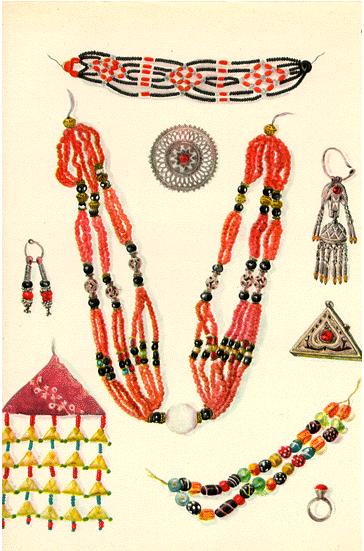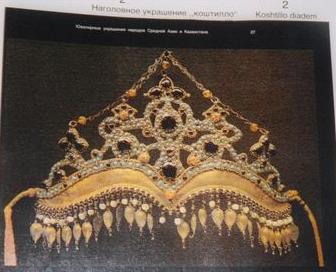
Transoxiana 11 - Julio 2006
Índice

|
Transoxiana 11 - Julio 2006 |
Jewelry is one of the most conservative arts, where technology and decorative elements prevail without fast changes. It is a property of jewelry art that give us for example a great opportunity to find Buddhists elements in 19th-20th centuries. One of the many examples of Tajik jewelry is a diadem. Traditional wedding crown or diadem is well-known as a "Kosh-tillo" or "Tillya-Kosh" (Golden eyebrows) has a heraldic composition of lion, monkey and turtle figures. These three animals are representative of Buddha. In some legends of the Buddhist culture, the Buddha Shakjamuni appears as a monkey, bird or deer. Another image of Buddha -monkey is the Blessed Hanuman (son of Wind God Vau or Maruta and monkey Adjanta) From India the cult of Hanuman spread to Eastern Asia and China. There are stories where the Buddha appears as a lion or lioness is a maternity symbol and is attributed to Mother -God. At the same time lionesses symbolized health or magic. The third symbol - turtle is not only one of the images of Buddha, but also a symbol of longevity. We currently know that the Buddhist elements in Tajik jewelry are not only products of Indian jewelers who worked in Tajikistan during the 19 and the beginning of the 20 century. Buddhist art was one of the processes in the development of Central Asian art, because Buddhist culture was one of the elements of Tajik history.
 Another type of tajik jewelry articles included "brooches-fibulas," which is known as "kulfi-girebon".[Round metal fastenings-fibulas are known through southern Kyrgyz, Kazakh and Turkmen people.] The Fund Collection of jewelry , at the Museum of Ethnography, replenished its collection with jewelry pieces made by Kulyabian jewelers. A unique collection of jewelry, ceramics, clothes, furniture and other crafts is held in Dushanbe, at the Museum of Academy of Science of Tajikistan. All historical items, include jewelry were collected by generation of ethnographers and art historians from 1948 to 1990? (civil war begins) as N .Ershov, A.Pisarchik, B. Karmisheva, M. Khamidjanova, T.Mezurnova and others including E. Neva. Most of museum items date from 19th and 20th centuries and collection of jewelry consisting 300 articles (as of 1990) These articles also include the well-known brooches. Brooches were not only made of silver, but also from German silver (an alloy of nickel and copper).
Another type of tajik jewelry articles included "brooches-fibulas," which is known as "kulfi-girebon".[Round metal fastenings-fibulas are known through southern Kyrgyz, Kazakh and Turkmen people.] The Fund Collection of jewelry , at the Museum of Ethnography, replenished its collection with jewelry pieces made by Kulyabian jewelers. A unique collection of jewelry, ceramics, clothes, furniture and other crafts is held in Dushanbe, at the Museum of Academy of Science of Tajikistan. All historical items, include jewelry were collected by generation of ethnographers and art historians from 1948 to 1990? (civil war begins) as N .Ershov, A.Pisarchik, B. Karmisheva, M. Khamidjanova, T.Mezurnova and others including E. Neva. Most of museum items date from 19th and 20th centuries and collection of jewelry consisting 300 articles (as of 1990) These articles also include the well-known brooches. Brooches were not only made of silver, but also from German silver (an alloy of nickel and copper).
The form of the brooch reminds the observer of the round disk that we call the sun. Shaped as a rosette, its middle has a medallion with an insertion - the medallion is decorated with triangles from granulation. Granulation of triangles also covers the edges of the brooch, probably portraying a bright sun and its rays.
A distinctive feature in the technology of artistic processing of metal is granulation, which consists of tiny metal balls, that help create decorative ornamental compositions, giving the artifact a special appearance.
Soldered over the metallic rays are filigree miniature half-spheres, small in height and shaped as rosettes. These can portray planets revolving around the sun, or stars. Descending pendants on a wicker wire symbolize rain which gives life to earth and helps the growth of life creating seeds
The brooches central insertion was usually made out of coral, because this particular stone was symbolically related to the sun. Sometimes red carnelian was used, known as "hakik" - it was said that, "whoever wears it, lives in constant happiness".
Brooches, writes L. Chvir, are a typical jewelry article of Southern Tajikistan. The most common are the so-called "kulfi-girebon," also known as kulyabian filigree fibulas. These fibulas are sometimes decorated with rare insertions of red glass or stones and have pendants made of chains and "leaves". The diameter and weight vary widely: the brooches are of various sizes, which can differentiate their age.
The complexity of Kulyabian jewelry is noted in the manuscript "Tajik Jewelry" which states, " the peculiarity of the Kulyabian jewelry is due to the presence of the round filigree brooch "kulfi-girebon" in it". The brooch was worn on the collar and also worn with beads.
The filigree brooch, in the form of the sun, was not just a type of amulet protection that had a clear astral symbolism (related to fertility and brides: moon - groom; sun - bride). However, also had a clear function of protection, because the brooch was placed on the location of the solar plexus - an important internal organ. The damage to the solar plexus may result in death; this once again proves the depth of knowledge of our ancestors.
Nowadays the brooches are practically out of style; the original brooches were replaced by factory-made small brooches, decorated with glass - a reminder of the familiar fibulas.
Fibulas, as adornments are known from the past. Brooches-fibulas were placed on the shoulder on a cloak in the times of Ancient Rome. Currently these adornments are known as an indispensable complement to the jewelry ensemble of Turkmen people; even now, fibulas are placed on the shoulders of Latish people. The use of such brooches can be noticed in other nations as well, for example Hungarians.
An analogous pendant in the form of a brooch is used in India. This fact can be traced through paintings of Manjurian and Maisurian schools of the XVIII-XIX centuries in southern India.
 Undoubtedly, in the past, the wearing of such an adornment had the function of differentiating among the levels of society. In Indian sculptures and paintings the fibulas are worn by their gods.
Undoubtedly, in the past, the wearing of such an adornment had the function of differentiating among the levels of society. In Indian sculptures and paintings the fibulas are worn by their gods.
The relationship between such an adornment and the Buddhist religion is shown in sculptures from Adjina-tepe. On one of the torso's of devata, from the neck to the chest drops an adornment analogous to our brooch - "kulfi girebon".
Findings of the last couple of years include a Buddhist cloister of the VII and VIII century in Chepivol. This once again shows us the accurateness of the words of Chinese historians that the south of Tajikistan had been a home for many Buddhist cloisters during the early middle ages. This is the reason why even today one may notice the effects of the Buddhist culture on jewelry articles, not just in the southern regions of Tajikistan.
There still is no answer as to whether Buddhism was an official religion of the territory of Tajikistan, but the notion of its being very common in the region is already obvious.
Antipina, K.I., Osobennosti materialnoi culturi I prikladnogo isskustva yujnikh kirgizov, p.262
Ivanov, S.V. and E.I. Mahova, Khudojestvennaya obrabotka metalla. Narodnoe dekorativno-prikladnoe isskustvo kirgizov. M, 1986, pp.96-122
Zakharova, I.V. and R.D. Khodjaeva, Kazahskaya nazionalnaya odejda XIX nachala XX v., pp.139-140